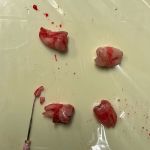1. Understanding Tooth Pain After Filling: What Happens?
Experiencing tooth pain after a dental filling can be concerning and confusing. Many patients wonder about the causes of tooth pain after dental filling and whether it is a sign of a serious problem. It’s important to understand that some level of discomfort or sensitivity is common following a dental procedure. This pain occurs because the process of removing decay and placing a filling irritates the nerves inside the tooth. The tooth may need time to adjust to the new filling, especially if the decay was deep or close to the nerve.
However, tooth pain after filling varies widely among individuals, influenced by factors such as the extent of decay, the type of filling material used, and individual pain tolerance. Knowing the difference between expected sensitivity and warning signs of complications is key to managing your oral health effectively.
1.1 Patient Perspective: Jane’s Experience
Jane, a 35-year-old teacher, noticed sharp pain in her molar days after getting a composite filling. Initially, she thought the sensitivity was normal, but as the pain worsened with cold drinks, she sought professional advice. Her story highlights the importance of monitoring post-filling symptoms carefully and not ignoring persistent pain.
2. Common Causes of Tooth Pain After Dental Filling
The causes of tooth pain after dental filling can be broadly categorized into several factors:
2.1 Pulpitis – Inflammation of the Tooth Nerve
Pulpitis occurs when the dental pulp, the innermost part of the tooth containing nerves and blood vessels, becomes inflamed. This can happen if the decay was deep or if the filling placement irritated the pulp. Symptoms typically include sharp, throbbing pain and increased sensitivity to temperature changes. In mild cases, this inflammation resolves on its own, but severe pulpitis may require further treatment like a root canal.
2.2 High Bite or Occlusal Trauma
If the filling is slightly higher than the surrounding teeth, it can cause an uneven bite, leading to excessive pressure when chewing. This occlusal trauma can result in persistent pain or discomfort, often felt when biting down. Adjusting the filling by the dentist usually resolves this issue quickly.
2.3 Tooth Sensitivity
Sensitivity after a filling is common, especially with composite fillings. The tooth may react to hot, cold, sweet, or acidic stimuli due to the temporary irritation of the dentin tubules. This sensitivity typically diminishes within a few weeks.
2.4 Microleakage and Secondary Decay
In some cases, gaps between the filling and tooth allow bacteria to enter, causing microleakage. This can lead to recurrent decay beneath or around the filling, triggering pain. Identifying and treating this early is crucial to prevent further damage.
3. Tooth Sensitivity Versus Persistent Pain: Knowing the Difference
Distinguishing between normal post-filling sensitivity and persistent pain is essential. Sensitivity is generally mild, triggered by specific stimuli, and resolves within a few days to weeks. Persistent pain, on the other hand, may be spontaneous, intense, and worsen over time.
Recognizing these differences can help patients decide when to seek dental care. Ignoring persistent pain might allow underlying issues such as pulpitis or infection to worsen.
4. The Role of Filling Material and Technique in Post-Filling Pain
The choice of filling material and the dentist’s technique significantly influence post-filling discomfort. Amalgam fillings, while durable, can sometimes cause sensitivity due to metal expansion and contraction. Composite fillings bond to the tooth but may cause more initial sensitivity due to the bonding process.
Technique matters too. Proper isolation during filling placement, layering composite materials carefully, and ensuring the bite is correctly adjusted all reduce chances of post-procedure pain. Experienced dentists pay close attention to these details to minimize discomfort.
5. Real Case Study: Managing Pain After a Large Filling
Consider the case of Tom, who had a large cavity filled on a lower molar. Following the procedure, he experienced sharp pain when biting and lingering sensitivity. After a detailed examination, his dentist identified a high filling causing occlusal trauma and mild pulpitis. The dentist adjusted the bite and prescribed anti-inflammatory medication. Over the next two weeks, Tom’s symptoms improved significantly. His case emphasizes the importance of follow-up care and tailored treatment.
6. When to See a Dentist for Tooth Pain After Filling
While some discomfort is expected, patients should see a dentist if they experience:
- Severe or worsening pain not relieved by over-the-counter painkillers
- Persistent sensitivity lasting more than two weeks
- Swelling or signs of infection around the tooth or gums
- Sharp pain when biting or chewing
- Visible cracks or changes in the filling
Early intervention prevents complications and helps maintain dental health.
7. Preventing and Managing Post-Filling Pain Effectively
Preventing tooth pain after a dental filling begins with choosing an experienced dentist who uses advanced materials and techniques. Proper oral hygiene and avoiding hard or sticky foods immediately after the procedure reduce risks.
For pain management, over-the-counter analgesics, cold compresses, and avoiding temperature extremes can provide relief. If sensitivity persists, professional evaluation is vital.
For patients seeking trusted information, resources like Dentistry Toothtruth offer guidance on products and services that support dental recovery and care.







 David A. Goodman, DMD Alan C. Ko, DMD Advanced Cosmetic & Prosthetic Dentistry5.0 (333 review)
David A. Goodman, DMD Alan C. Ko, DMD Advanced Cosmetic & Prosthetic Dentistry5.0 (333 review) Glen Allen Dentistry4.0 (235 review)
Glen Allen Dentistry4.0 (235 review) Dr. Mark Mendiola, DDS4.0 (8 review)
Dr. Mark Mendiola, DDS4.0 (8 review) Smile Philly! Deepa Patel, D.M.D.4.0 (171 review)
Smile Philly! Deepa Patel, D.M.D.4.0 (171 review) Arthur Glosman, DDS5.0 (366 review)
Arthur Glosman, DDS5.0 (366 review) LAX DENTAL and ORTHODONTICS4.0 (107 review)
LAX DENTAL and ORTHODONTICS4.0 (107 review) The Importance of Oral Health Education During Pregnancy for a Healthy Pregnancy
The Importance of Oral Health Education During Pregnancy for a Healthy Pregnancy Best Tips for Brushing Your Teeth Properly for Healthy Gums: Essential Techniques for Oral Health
Best Tips for Brushing Your Teeth Properly for Healthy Gums: Essential Techniques for Oral Health Why Skipping Dental Checkups Can Lead to Bigger Oral Health Problems
Why Skipping Dental Checkups Can Lead to Bigger Oral Health Problems Advantages of Porcelain Dental Restorations
Advantages of Porcelain Dental Restorations How Can Diabetes Cause Tooth and Gum Problems? Preventing and Managing Oral Health Issues
How Can Diabetes Cause Tooth and Gum Problems? Preventing and Managing Oral Health Issues Healthy Habits for Promoting Good Oral Health and Hygiene: Tips for a Healthy Smile
Healthy Habits for Promoting Good Oral Health and Hygiene: Tips for a Healthy Smile